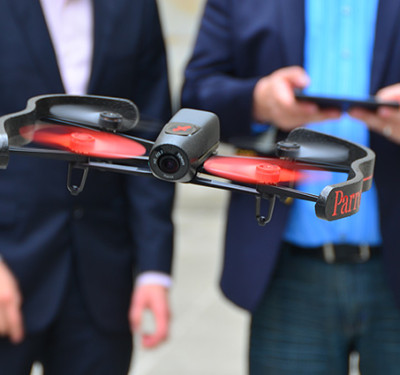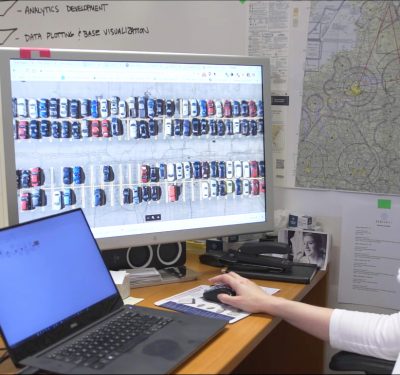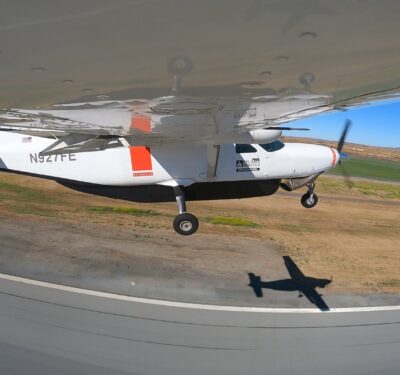According to a new report the market for civil, commercial and consumer drones will expand from $2.8 billion in 2017 to an annual level of more than $11.8 billion by 2026—a compound growth rate of 15.5 percent.
Customers are expected to spend a total of $73.5 billion across all three sectors during those 10 years with the value of the commercial drone market outpacing that of the consumer market by 2024, according to the World Civil Unmanned Aerial Systems Market Profile & Forecast by the Teal Group. The report includes data for the drones themselves and those sensors sold with the systems, but not after-market sensors.
The study looks at mini unmanned aircraft systems (UAS), that is those less than 55 lbs., as well as prosumer and small, higher-end drones for use by government agencies doing, for example, maritime patrol or firms doing pipeline inspections. It also examined the market for tactical unmanned aerial vehicles (UAVs) for civilian government tasks such as peacekeeping and medium- and high-altitude aircraft for applications like border monitoring and drone-based Internet networks for underserved areas. The conclusions are grounded in extensive interviews, said Philip Finnegan, Teal’s director of corporate analysis.
Though sales of consumer UAS will still grow, and the sector is forecast to make up just over half of the total 10-year market, the sector is maturing. The fastest growth is now expected in the commercial sector according to the World Civil Unmanned Aerial Systems Market Profile & Forecast, driven in part by the surge of interest among technology leaders like Intel, Sony, Google and Facebook.
“The greater maturity of the consumer UAS market will limit that growth to rates well below the explosive growth of the commercial and civil government markets” according to Teal. “Nonetheless, it will continue to expand thanks to new technological developments and a wider range of product offerings. Moreover, there promises to be considerable crossover between the consumer and the commercial UAS markets.
Fastest Growing
Teal projects that construction will be the fastest growing market for commercial UAS from 2017 through 2026.
“The 10 largest worldwide construction companies are all either working to integrate or are studying the integration of UAS in their operations. The three largest construction equipment companies are adding UASs to their product lines, either from an outside vendor or through developing their own systems,” wrote Teal. “The mix of systems for construction will range from prosumer systems for simple tasks like roof inspections to higher end, relatively autonomous mini systems that are able to track progress on construction sites.”
“There’re a couple of different reasons for that,” said Dan Kara, the research director for robotics for ABI Research. First, Kara said, there is a quicker payoff for using unmanned aircraft in the construction industry.
For example, he said, you typically show the investors how things are coming along by walking people through the construction site every few weeks.
“That’s a tiresome process. It’s expensive to do and it’s difficult to see some of the things that are happening,” he said. “Drones make that very easy to do.”
Data from drones is also being used in 3-D modeling software packages that are tailored to the construction industry. “You can not only monitor the pace of construction, you can see how things are happening,” Kara said.
That kind of oversight is crucial, for example, when it comes to moving materiel around a large site.
“Certain things have to occur at precise times—otherwise, for example, roads get blocked up or you can’t move debris away that you want to do. Drones allow you to do that very, very effectively and see the whole site at one time.” If you make a mistake, he said, and put a pile of gravel in the wrong place it sets back construction and sends costs up. “There’s dollar values that are tied into this immediately.”
Reality Check
Companies are adapting, Finnegan said, as they deal with the crucible of the marketplace. Software firms, for example, are getting into hardware and services, he said, “broadening their footprint in the market to capture business.”
“It’s still an immature market,” Finnegan explained, “so you need to be nimble and you need to go where the sales are—so that’s what they’re working on doing.”
Finnegan added that he was struck this year by the extent to which technological innovation was becoming focused in the United States and the degree to which venture capital was flowing to U.S. firms.
Overall, 66 percent of the venture capital invested in drones from 2012 through May 2017 went to American companies, Teal reported. That “infusion of venture capital is creating an industry of startups in both manufacturing and the services that will be critical to development of the commercial market.”
Moreover, over that time period, U.S. firms received 14 times more venture capital than their European counterparts, which has helped inspire a migration of sorts. Firms from across the EU are opening offices in the U.S., even moving their headquarters there, to be where the money is and to be able to tap into the flow of technology, These companies are also looking to gain experience in a marketplace that is now moving faster than markets elsewhere, Finnegan said.
“It’s technology,” Finnegan said. “It’s funding and it’s also a big market and the (Federal Aviation Administration) with Part 107 opening up that market.”
Growth Potential
While substantial, the growth rate forecast by Teal is especially interesting for what it didn’t capture: the huge markets in agriculture and drone delivery. Development in these markets is running slower than in other sectors so their potential largely falls outside of the 10-year forecast period.
“There is agriculture in the forecast but it’s less than it was before,” Finnegan told Inside Unmanned Systems. Part of the problem is that the algorithms supporting the sector aren’t fully developed. Moreover, because the technology still has a ways to go, “some of the earlier adopters may have gotten burned—they didn’t get what they were promised in terms of output.”
Agriculture also lacks the structural advantage of other sectors, like energy, where a handful of global companies can quickly adapt and adopt new technology across all their operations—driving rapid growth.
“Worldwide enterprises, like for example oil and gas companies, they develop a program, they examine exactly where the use of the UAS is feasible and they start using it in those areas on a worldwide basis,” Finnegan said. “So it has the potential to develop very quickly, worldwide, based on these large enterprises. You don’t have that in agriculture.”
“Agriculture is potentially a very large market,” Finnegan concluded, “but it’s going to develop relatively slowly.”
Kara agreed, saying his firm felt some of the early assertions that agriculture would be the primary market “just didn’t ring true.”
“This is a good example of where, in theory, everything would kind of come together,” said Kara. You have private land where the regulatory burdens are less and you have a real need to cut back on the amount of pesticides and other types of chemicals that you put down.
“All of that is true,” Kara said, “and the technology has improved—but there’s still these other gating factors where they’re just not interested.”
Part of that lack of interest is tied to farm commodity prices and some is because smaller farmers are not interested in taking on the technology.
“We started going deeper into that and then brought down the numbers considerably,” Kara said. While this sector is still “growing pretty robustly in terms of total ecosystem revenue” ABI is going to be re-evaluating the future of that market as well as others including film and media. “We just do not see this evolving in the same time frame or even near what other people are saying after our conversations with people.”
Betting On the Future
However the individual sectors rise and fall, the investors are declaring their faith in the UAS industry with hard cold cash.
“The last two full years were a particularly heady one for drone venture capital investment,” reported Teal. “The largest 60 companies for venture capital investment brought in three times as much investment in 2015 as the previous year. Investment soared from $155.5 million in 2014 to $486.4 million in 2015. It declined only slightly in 2016 to $454.5 million.”
As of the spring of 2017 that trend was still holding, Teal reported, with venture capitalists (VCs) investing $168 million in the industry during the first four months of the year. Overall, a total of $1.35 billion in venture capital has been invested from 2012 through the beginning of May 2017 in the 60 largest drone companies targeted by the VCs.






